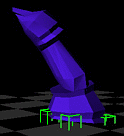 Wild walk (Mpeg-1 movie, 387196 Bytes).
Wild walk (Mpeg-1 movie, 387196 Bytes).
The reasons for associating linear splines with the coordinate directions parallel to the base are twofold: The low number of DOF's of the linear splines reflect the fact that the dimensions of the base are relatively small when compared to the height of the model; and having linear splines along the base allows us to keep the the base on the floor, or chess board, by constraining only four points around the base.
 Wild walk (Mpeg-1 movie, 387196 Bytes).
Wild walk (Mpeg-1 movie, 387196 Bytes).
We went on to define a walking motion for the knight by alternately moving two constraint points on the left side of the model, followed by moving two constraint points on the right side. There is a pause every time one side comes in contact with the floor while the other side to moves.
 Nice walk (Mpeg-1 movie, 390764 Bytes).
Nice walk (Mpeg-1 movie, 390764 Bytes).
This first attempt at making the knight walk proved to be unsatisfactory because the motion of the constrained points caused the whole model to flop back and forth a bit too wildly. We stabilized the motion by contracting the sides of the knight in unison with the lifting motion. The contraction was generated by animating the reference values for the shape points around the base of the model. This resulted in a pleasing walking motion with just enough rocking to give the viewer a sense of the mass of the object.
The simulation time for this walking animation was approximately 0.8 seconds per frame. The computation was performed on a Silicon Graphics Indigo2 workstation with a 150Mhz. R4400 CPU.
 Lift and wriggling motion (Mpeg-1 movie, 387228 Bytes).
Lift and wriggling motion (Mpeg-1 movie, 387228 Bytes).
The contractions used to stabilize the walking animation are are shown clearly in this animation where the knight is lifted off the ground after taking a few steps. The contractions used in the above walking animation cause the wriggling motion after the knight has been lifted off the chess board.
The original model of the knight chess piece is (c) Randy Brown and was taken from an Inventor data file distributed with Silicon Graphics computer systems.
Back to: Examples | Rudy's Home Page